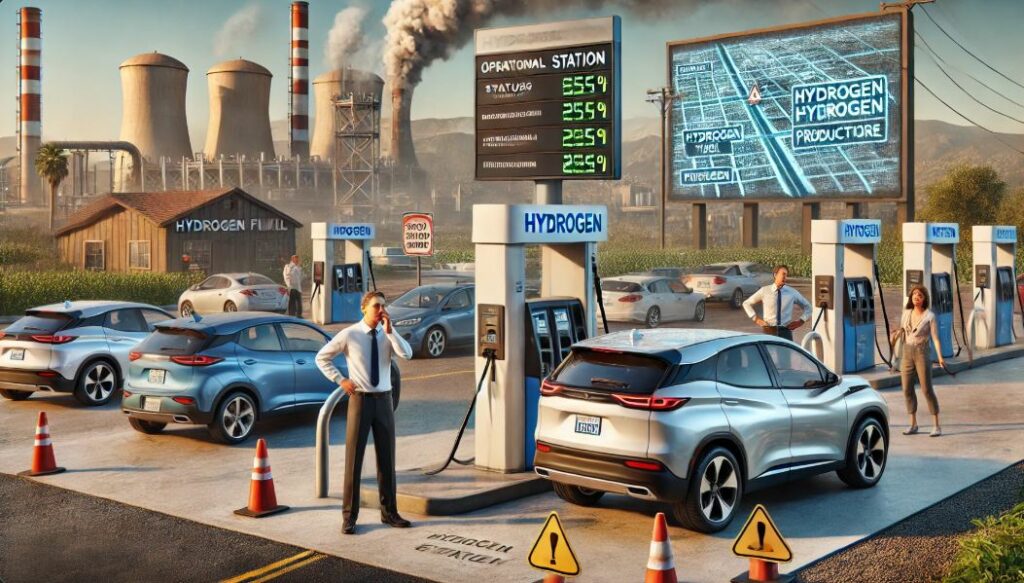The promise of a hydrogen-powered future has long been touted as a transformative solution to the energy and environmental crises. Companies like Toyota have been at the forefront of this narrative, leveraging their market dominance and technological prowess to drive the adoption of hydrogen fuel cell vehicles (FCEVs). However, beneath the surface lies a tangled web of consumer grievances, legal disputes, and systemic technological flaws that cast doubt on the viability of hydrogen as a sustainable alternative.
The Mirage of Hydrogen Infrastructure
California, often lauded as a progressive leader in renewable energy, has served as the primary testing ground for hydrogen vehicles. With Toyota’s Mirai accounting for nearly 88% of the state’s hydrogen-fueled cars, the company’s dominance in this space is unmistakable. Yet, this dominance has not translated into consumer satisfaction or infrastructure reliability.
As of 2024, California boasts fewer than 30 functioning hydrogen refueling stations—far short of the 100-station goal set by Governor Gavin Newsom in 2020. Publicly funded initiatives, such as the California Energy Commission’s grants, have funneled millions into hydrogen station development, only to see many of these facilities fail within a year. Reports reveal systemic issues ranging from frequent outages to dangerously malfunctioning pumps, leaving drivers stranded and disillusioned.
The root of these failures is multifaceted. Toyota’s insistence on controlling refueling standards has created significant barriers for alternative operators, such as California State University, Los Angeles, whose clean hydrogen station was effectively sidelined despite meeting rigorous safety and performance standards. Instead, stations financed by Toyota or its affiliates, like First Element, dominate the network, further entrenching a cycle of dependency and inefficiency.
Consumer Experiences: From Trust to Turmoil
The stories of Mirai owners highlight the stark realities of hydrogen adoption. Promises of seamless refueling, environmental benefits, and cutting-edge technology have often turned into nightmares marked by unreliable infrastructure, inflated costs, and unresolved safety concerns.
One striking example is Zachary Graham, a U.S. Marine Corps officer whose military career and financial stability were jeopardized by his decision to purchase a Mirai. Misled by dealership assurances of robust refueling networks and long-term cost savings, Graham found himself trapped with a vehicle that he could neither use nor sell. His experience underscores the broader issue of deceptive sales practices that fail to disclose the limitations of hydrogen fueling infrastructure.
Similarly, 77-year-old Jaime Nahman’s ordeal illustrates the intersection of inadequate technology and exploitative marketing. Despite being a loyal Toyota customer, Nahman found himself grappling with frequent breakdowns, invasive data collection, and non-existent resale value. His experience reveals how Toyota’s branding efforts leverage consumer trust while downplaying critical flaws.
Legal Fallout: The Case Against Toyota
The mounting dissatisfaction among hydrogen vehicle owners has culminated in a series of legal challenges. A notable lawsuit filed in California accuses Toyota of engaging in deceptive practices, false advertising, and negligence. Plaintiffs argue that the company knowingly sold vehicles reliant on an inadequate and unsafe refueling network, causing financial, physical, and emotional harm.
Key claims include:
- Misrepresentation of fueling infrastructure reliability, leading to frequent and prolonged outages.
- Environmental deception, with hydrogen production heavily reliant on methane—a process that contradicts the green image projected in marketing campaigns.
- Safety concerns, including faulty pump nozzles and misrepresented fueling times.
Documents submitted in the case reveal that Toyota has been aware of these issues for years. For instance, Canadian government data shows that one-third of attempts to refuel hydrogen vehicles failed, yet Toyota continued to promote the Mirai in California with claims of five-minute refueling under “real-world” conditions.
Technological Challenges: The Broken Promise of Hydrogen
At the heart of the hydrogen controversy lies a fundamental question: Is the technology ready for widespread adoption? Evidence suggests that the answer is no.
Hydrogen refueling stations suffer from a litany of technical failures, including frozen nozzles, pump explosions, and frequent breakdowns. These issues are compounded by the inherent limitations of hydrogen storage and distribution, which require high-pressure systems that are both costly and prone to malfunction.
Moreover, the environmental argument for hydrogen is far less compelling than advertised. The majority of hydrogen in California is produced using natural gas, emitting significant amounts of CO2 and perpetuating reliance on fossil fuels. Despite the theoretical potential of green hydrogen, derived from water through electrolysis, the lack of infrastructure and high costs make this approach impractical in the near term.
A Manufactured Monopoly
Toyota’s influence over California’s hydrogen ecosystem extends beyond vehicles and stations to quasi-governmental entities like the California Fuel Cell Partnership. Allegations of undue pressure and manipulation have emerged, including Toyota’s veto power over which stations are listed on official fueling maps.
For example, California State University, Los Angeles, built a taxpayer-funded clean hydrogen station only to face relentless opposition from Toyota. Despite meeting state-approved standards, the station was excluded from fueling maps at Toyota’s behest, effectively cutting off its customer base and forcing its eventual closure. This pattern of obstruction raises questions about the fairness and transparency of hydrogen market dynamics.
The Human Cost
Beyond the technical and environmental concerns, the human toll of hydrogen adoption cannot be overlooked. Consumers like Jane Doe recount harrowing experiences of being stranded at malfunctioning stations late at night, dealing with aggressive drivers vying for limited fuel, and enduring financial hardship due to vehicles with plummeting resale values.
These experiences highlight the broader ethical dilemma: Should companies and governments promote technologies that are not yet viable, especially when the consequences disproportionately affect vulnerable populations?
Cautionary Tale
California’s experiment with hydrogen-powered vehicles offers a cautionary tale for policymakers, automakers, and consumers alike. While the vision of a hydrogen economy remains alluring, the current state of the technology, infrastructure, and market practices reveals a reality fraught with challenges.
For Toyota, the legal and reputational risks associated with its hydrogen strategy are mounting. For California, the question remains whether continued investment in hydrogen infrastructure is justified in light of its poor performance and environmental contradictions. And for consumers, the lesson is clear: Promises of innovation must be met with scrutiny, skepticism, and accountability.





